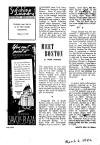
Home Page Meet Boston Menu Index
|
MEET BOSTON Friday, March 6, 1942 in What's New In Town W. J. Sidis |
Bananas were first introduced to America through Boston. Some 70 years ago, the banana was a fruit known only in the tropical countries where it grew. Then a Massachusetts sea captain, down trading in South America, tasted some bananas, liked then, and decided his friends back home would like some. And so he loaded a few bunches of green bananas into some spare space in the hold of the ship, and took them back to Boston that way. The popularity of the fruit was more than he expected, and, on his next voyage to South America, he found himself loaded with orders for more bananas. And so the business grew―one of America’s greatest shipping systems to our Southern neighbors grew out of it. And, if you like bananas, you may have frequent occasion to recognize the value of Boston’s gift to America.
*
Telegraph Hill, in South Boston, owes its name to the semaphore (then called “telegraph”) which, a hundred years ago, used to signal the approach of vessels bound for this port. This hill was the original “Dorchester Heights” from which the rebels in 1776 forced the British to evacuate Boston. It is there that the Dorchester Heights monument now stands. Until lately, the Andrew Square region, to the west of the heights, was known as Washington Village, it being from there that George Washington operated while the hill was being fortified. The hill itself was at one time called Mount Washington.
*
King’s Chapel has the distinction―apparently a contradictory one―of being the first Episcopalian church in New England, and of being the first Unitarian church in America. It was originally built on land confiscated in 1685 by New England’s hated dictator Andros for the purpose of providing a church for the British aristocrats he brought over here with him. It received its name because the King is the head of the Episcopal Church in England. As royal property, it was again confiscated in the American Revolution. In 1782, it was reopened by a Congregational group which had adopted the new principles which soon after became known as Unitarianism.
*
A recent radio information program inquired as to the first tabloid newspaper. The answer given―and approved―on that program was a paper in London, alleged to have been run as a tabloid “as far back” as 1908. Wrong as usual, brother! The correct answer is, the Boston Evening Transcript, started as a tabloid on July 24, 1830. The size of the pages was not much larger than a modern sheet of typewriter paper, and larger pages were not used on this paper for over 20 years. The first imitator the Transcript had as to its tabloid style was a New York paper called the Sun, started in 1833.